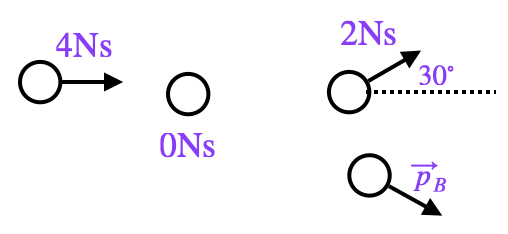2D Collisions
It is important to remember that when we calculate the total momentum of a system, we must add the momenta as vectors, not as numbers. Direction really does matter.One place where this can be useful is in the study of explosions: when something starts at rest and then breaks into multiple pieces due to some internal force. If the object breaks into two pieces, then the pieces must initially move in opposite directions, because the only way for two momenta vectors to add up to zero (the initial momentum, which is conserved) is if the vectors point in opposite directions. It's also impossible for one piece to fly off in one direction while the other stays stationary: the two must have equal and opposite momenta. This is why a gun recoils (or jerks backward) when it flings the bullet forward. Rockets use recoil to propel themselves through space. If there are more than two pieces then other results are possible, although the total momentum of all the pieces must still add up to the initial momentum. For example, in this picture, even if the two horizontal momenta add up to zero, there is still a net downward component of momentum which cannot be balanced by any of the others. From this we can deduce that this bomb was initially moving downward when it exploded.
We might also need to think about two-dimensional momentum in collisions as well, such as in the game of pool where players will try to hit the ball off-center to make it go in a specific direction. Here is an example:
Example
A pool ball with momentum 4Ns to the right approaches a pool ball which is stationary. Suppose that, after the collision, the original pool ball has a momentum of 2Ns and is moving off at an angle 30° above the horizontal. What is the momentum of the other ball?
The initial momentum is $(4,0)$, and the momentum of the first ball after the collision is $(+2\cos 30\deg,+2\sin 30\deg)$. We don't know anything about the second ball's momentum after the collision, so let's write it as $(p_{Bx},p_{By})$. Momentum conservation tells us that $$(4,0)=(2\cos30^\circ,2\sin30^\circ)+(p_{Bx},p_{By})$$ which splits into the two equations $$\begin{align} 4&=2\cos30^\circ+p_{Bx} &\implies p_{Bx}&=2.27\mathrm{Ns}\\ 0&=2\sin30^\circ+p_{By} &\implies p_{By}&=-1\mathrm{Ns}\\ \end{align}$$ Thus the momentum of the second ball is $(2.27,-1)\u{Ns}$, with a magnitude of $p_B=\sqrt{(2.27)^2+(1)^2}=2.5\u{Ns}$, a little larger than that of the first ball.